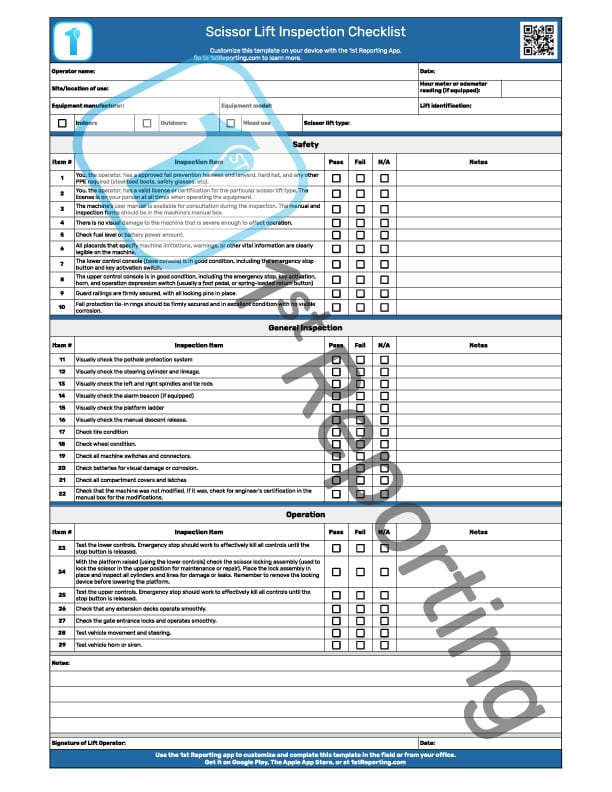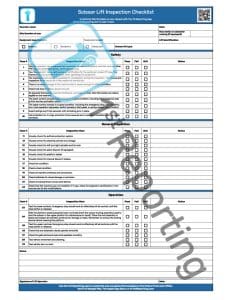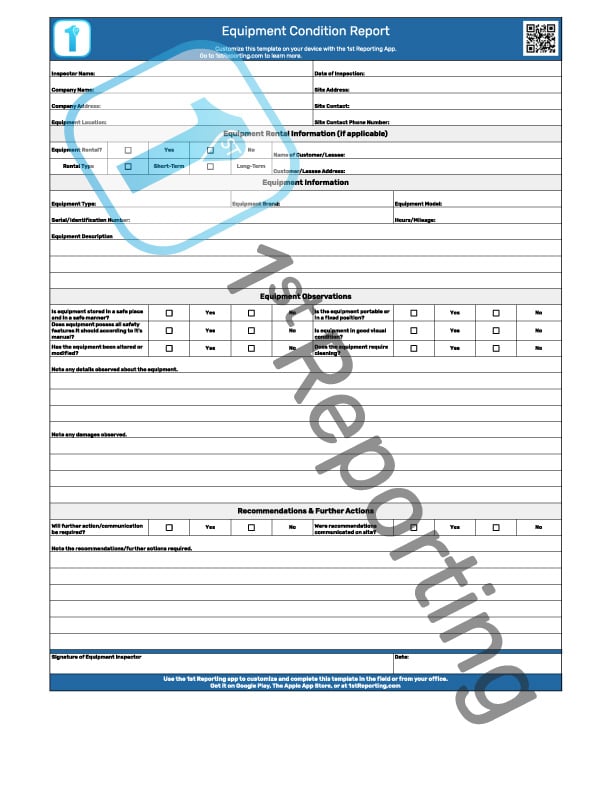Scissor Lift Inspection Checklist tools are vital for operators to maintain consistent safety inspections of essential lift equipment. Utilizing a templated checklist for the equipment daily safety audit (or pre-use safety audit) will aid in uniform operations. It will also help reduce missed key safety points vital to a complete inspection.
The Scissor Lift Inspection Checklist we have for you to download is a general template to help you deliver a uniform and robust safety experience. Team members can follow the simple three-stage inspection process outlined by the checklist for efficient and uniform equipment inspections.
We’ll deliver the critical information you need to know about the checklist. And we will also mention a few things that could help you drastically improve your inspection process, so stick with us to the end, and it will be worth it (even if you download the template first).
Included In The Scissor Lift Inspection Checklist

The Scissor Lift Inspection Checklist conveniently segments into five major component sections:
- Administrative
- Safety
- General Inspection
- Operation
- Notes and Sign Off
Following, you will find a quick reference style description of each section. Feel free to bookmark this page to use it to help train your staff on the particular use of the checklist.
Administrative
No report would be complete without an administrative section to identify critical factors pertaining to the documented information. In this instance, the information we are talking about refers to the operator name and date, the make and model, and the equipment identifier.
Safety
Because a pre-use inspection of lift equipment is primarily safety-driven, we felt it prudent to provide this portion of the assessment first. This section of the checklist includes the standard safety fare associated with the usual types of scissor lifting equipment.
General Inspection
Following a safety inspection of equipment, the general examination continues to ascertain the use of the equipment. This section includes multiple visual inspections of components and some checks that may involve physically touching the machine, such as compartment cover latches.
Operation
After a complete visual inspection noting safety and general components, it is time for the operator to test the equipment operationally. This section of the scissor lift inspection checklist includes the standard items associated with the most common rental commercial-grade scissor lifts.
Notes and Sign Off
Finally, on the Scissor Lift Inspection Checklist, we have provided here today (for free), you will find a blank area for the operator to include further inspection notes. Further to the notes is the last area where the operator/inspector should sign and date the report for authenticity.
Best Practices For Using The Scissor Lift Inspection Checklist
Some simple processes will aid your company with using the Scissor Lift Inspection Checklist. We recommend the following steps to get you started:
- Download the free template we have provided on this page.
- Make copies of the template for each day of the month when team members will use the equipment.
- Make extra copies of the checklist to accommodate for errors and extra operators (operator switches within a single day).
- Maintain a binder or other tool to keep the checklists free from damage and onboard the scissor lift. Many lifts have a built-in container for the manual that you can utilize to keep the checklist copies on board.
- Maintain a file where you can keep copies of the inspection checklists from previous periods. This filing system allows you to maintain a record, should you need it for legal reasons in the future.
- Train all equipment operators on the proper use of the checklist.
Further to utilizing our Scissor Lift Inspection Checklist and maintaining a strict filing system, it is essential to maintain the equipment properly. Using other checklists and templates such as an Equipment Condition Report for maintaining equipment or a Fleet Repair Request Form will vastly aid in maintaining equipment.
Will It Work For Rental Scissor Lifts?
Even if your company uses rental equipment, you will want to implement a strict scissor lift inspection protocol for your team members. Anyone using this sort of lifting equipment should complete a safety inspection of the equipment before its use. Maintaining this protocol will keep you on the right side of doing your due diligence for safety’s sake.
One of the biggest complaints about safety inspections is slowing down day-to-day operations. As you know, slow-downs can be costly, so we want to avoid such things.
To help, we’ve put together a list of tips that can help your business increase the inspection process’s efficiency. But that process doesn’t have to be equipment only. It could be facility inspection or even a form of audit, or even incident reporting. How? We’ll talk about that next.
4 Actionable Tips To Make Your Inspection Processes More Efficient With The Scissor Lift Inspection Checklist
Inspection processes are the backbone of quality management in any manufacturing or production setting. However, poorly managed inspection processes can lead to a host of problems, including decreased efficiency, lowered product quality, and even safety hazards. In order to ensure that your inspection processes are as efficient and effective as possible, follow these four tips:
Standardize Your Process
Your scissor lift inspection processes should be as formal and standardized as possible. Without this standardization, you will lose efficiency because it will make the process more complicated for employees.
For scissor lift inspections specifically, a company-wide checklist can ensure that all scissor lifts are inspected under the same guidelines and in the same way: this helps to increase quality and consistency while also reducing costs involved with scissor lift repairs.
Automate Your Mobile Form Processes
Increased mobile form automation is one of the best ways to streamline your inspection processes while simultaneously saving time and resources. However, choosing an effective mobile form builder can be challenging since so many companies are out there offering their services.
1st Reporting offers a simple scissor lift inspection form and other mobile forms and templates that can help you save time and resources while increasing scissor lift (and other equipment) inspection quality.
Determine Optimal Frequency
The scissor lift inspection frequency that you choose should be optimal for your specific scissor lift and regional bylaws. It’s essential to note that scissor lifts are used in various settings, all with their own scissor lift inspection standards. Consult the scissor lift inspection guidelines set out by OSHA or your local authority before making this decision.
Communicate With Employees After Inspection Process
An effective scissor lift inspection process must include feedback from employees about what needs improvement. If employees feel like they’re not involved in the scissor lift inspection process, they will lose faith and probably won’t take it seriously. Communicating with employees after inspections can identify potential issues in the future before they turn into incidents.
Eliminate Manual Entry Errors When Using A Paper Scissor Lift Inspection Checklist
Again we see the power of technology when it comes to manual data entry errors. Automating scissor lift inspection forms can help eliminate many of these errors. Similarly, ensuring a standardized template and process are utilized, as mentioned, will help reduce the error factor.
If you’re ready to test out a better solution, take a look at our mobile app for your mobile forms and inspecting needs.
Common Scissor Lift Questions Answered
How Often Should Scissor Lifts Be Inspected?
You should inspect scissor lifts in any of the following situations:
- Before Use (Daily)
- Operator Switch
- Annually
Each of these times allows for maximum safety for both operators and equipment. On any given day, when someone wants to use the equipment, your operator must inspect it. Similarly, if an operator switch occurs (like during a shift change), the equipment should be inspected by the new operator. This action applies our first rule that any operator must inspect equipment before use on the same day.
Finally, it is wise to have equipment inspected by a licensed mechanic on an annual basis. Depending on the amount of use, you may want to increase this inspection frequency to prevent costly repairs due to neglect and heavy use.
Does OSHA Require Annual Inspections On Scissor Lifts?
The OSHA may not be the ones to ask about annual inspections on scissor lifts. The OSHA deems scissor lifts to be a sort of portable scaffold. With that in mind, it is critical to inspect scissor lifts regularly, and in some regions, it may be mandated to do so.
For more in-depth information regarding scissor lift inspections, please read our article A Scissor Lift Certification And Inspection Guide For Business.
What Is The OSHA Standard For Scissor Lifts?
The OSHA has various standards that one could interpret to apply to scissor lifts. However, the rules that apply to scaffolding apply to scissor lift equipment at the OSHA. It is considered a mobile scaffold of sorts. This information is in reference to standard 1926.452(w), which covers mobile scaffold regulations.
The OSHA does not deem scissor lifts the same as aerial lifts, which get their standard based on the ANSI classification of the equipment. Due to the ANSI classification, scissor lifts do not qualify for the OSHA aerial lift standards, and thus the mobile scaffold standards apply. (source: OSHA)




